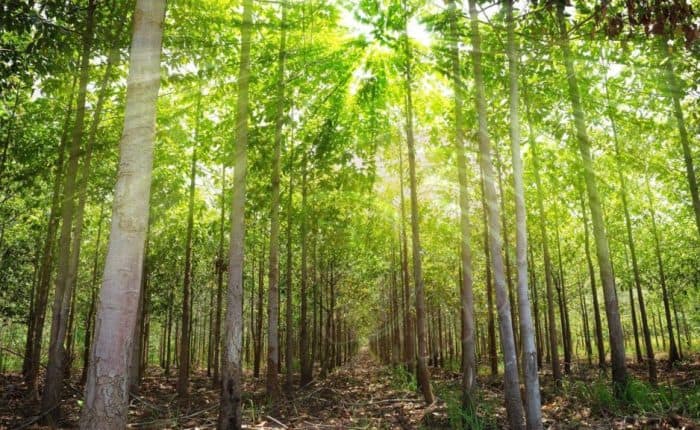Teak, scientifically referred to as Tectona Grandis, is a tropical hardwood species revered for its rich color, durability, and resistance to elements. Its robust quality and appealing aesthetics have historically made it a sought-after material for premium furniture, shipbuilding, flooring, and architectural detailing. Moreover, teak’s resistance to pests, rot, and weathering ensures it retains its value and desirability over time, bolstering its reputation as a material for high-end applications.
A constellation of factors is driving the burgeoning demand for this precious hardwood. Apart from its established reputation in the furniture and construction industries, teak’s use has diversified into sectors like renewable energy, particularly in the construction of wind turbine blades. Its unrivaled durability and robustness make it the material of choice for this industry. Additionally, the growth in the marine industry, where teak is often used in yacht and boat manufacturing due to its resilience against salt water, further fuels demand.
Ultimately, the intersection of teak’s unique properties, increasing consumer preference for high-quality hardwood, and its expanding use across industries creates a compelling case for investment in teak reforestation. These factors, together with the element of sustainability, position teak reforestation as an exciting, profitable, and ecologically responsible investment avenue.
Investment Opportunities in Teak Reforestation
Venturing into the realm of teak reforestation introduces investors to a world where financial returns and environmental stewardship go hand in hand. Teak reforestation essentially involves purchasing a plot of land, typically in tropical regions, planting teak saplings, and nurturing them until they reach maturity – a period spanning 20 to 25 years.
At maturity, these teak trees are harvested, and the wood is sold. The beauty of this model lies in its potential for repeated cycles, thereby creating a consistent source of income over the years.
The financial returns from teak reforestation are undeniably attractive, mainly owing to the robust demand and teak’s premium pricing in the global market. Furthermore, as teak matures and its quality improves over time, the value of the timber rises significantly, contributing to higher financial returns.
An aspect that sets teak reforestation apart from more volatile investment avenues is its inherent low-risk nature. The global teak market has proven to be resilient, remaining largely unaffected by economic downturns.
Moreover, teak trees continue to grow regardless of the state of the global economy, effectively insulating investors from market volatility. Importantly, the rise in sustainable practices has led to the introduction of insurance policies designed specifically for forest investments, offering an additional layer of risk mitigation.
Environmental Benefits of Teak Reforestation
The positive influence of teak reforestation on the environment is profound, offering investors an opportunity to make a tangible impact beyond the monetary gains.
Primarily, teak reforestation contributes significantly to improving biodiversity. By providing a new habitat, these plantations support a diverse range of flora and fauna. Moreover, they serve as an effective solution against soil erosion, especially in regions prone to tropical storms, thanks to teak’s extensive root system that offers substantial soil stability.
On a global scale, sustainable teak farming plays a pivotal role in combating climate change. It’s well-established that forests act as crucial carbon sinks, absorbing a significant portion of the carbon dioxide emissions that contribute to global warming. A single mature teak tree can absorb nearly 15 kilograms of carbon dioxide per year. Therefore, investing in teak reforestation contributes directly to the reduction of greenhouse gases in the atmosphere.
Further, the sustainability of teak reforestation is enhanced when the harvested trees are used in long-term applications such as construction or furniture, effectively locking the absorbed carbon for extended periods. By choosing teak reforestation, investors are supporting a circular economy that promotes resource efficiency and reduces carbon emissions.
Experience the Insider community that takes your international lifestyle to the next level. Download your FREE guide
"18 Steps to Implementing Your Plan B" instantly!
Investing in teak reforestation also aligns with global environmental conservation efforts. With increasing deforestation and illegal logging activities in many parts of the world, responsible teak farming provides a sustainable alternative to meet the growing demand for this valuable hardwood. As a result, it helps preserve existing natural forests and the invaluable biodiversity they harbor.
By investing in teak reforestation, individuals are not only bolstering their financial portfolios but also contributing meaningfully to environmental conservation and the fight against climate change. This dual return – financial gain and positive environmental impact – underpins the unique appeal of teak reforestation as a sustainable investment opportunity.
Building Generational Wealth through Teak Reforestation
Teak reforestation stands as a sterling example of an investment capable of spawning generational wealth. This notion is premised on the long-term nature of the investment, coupled with the potential for consistent, attractive returns.
Investing in teak stands unique in its ability to transcend temporal constraints. The growth cycle of a teak tree spans 20 to 25 years, and with proper management, a plantation can yield multiple cycles. This means that the financial benefits accrued from the initial investment can be enjoyed by not just the investor, but also subsequent generations. This aspect of continuity and compounded growth makes teak reforestation an ideal vehicle for creating generational wealth.
From a financial perspective, the long-term benefits of investing in teak are multifaceted. First, the value of teak timber increases as the trees mature, yielding higher returns with each passing year. Second, teak’s perennial demand and robust market price make it a highly liquid asset that can be sold readily when needed. Lastly, as a tangible asset, teak serves as a hedge against inflation, ensuring that the investment’s real value is preserved over time.
Additionally, there is potential for generating income during the tree’s growth phase. While the ultimate financial gain is realized upon harvesting mature teak trees, intercropping – growing short-term crops between the teak trees – can provide supplementary income during the growth period. This strategic approach not only maximizes the use of the land but also provides a steady income stream during the waiting period.
In essence, the unique characteristics of teak as a long-term, high-return, and low-risk investment combined with strategic plantation management can pave the way to generational wealth. It is an investment that does more than just grow; it flourishes over time, making it a legacy worth leaving behind.
Getting Started with Your Teak Reforestation Investment
Embarking on the journey of teak reforestation investment might seem daunting, but with the right guidance and due diligence, it can turn into a rewarding venture.
To get started, it’s essential to identify suitable locations for teak plantations. Teak thrives in tropical climates, with countries such as Costa Rica, Panama, and parts of Southeast Asia offering optimal conditions. Investing through reputable plantation management companies can simplify the process, as these entities often provide end-to-end services, from land acquisition and planting to tree maintenance and eventual harvesting.
Potential challenges in teak reforestation investment may include susceptibility to pests, variations in growth rate due to climatic conditions, and differing international regulations around timber trade. These can be mitigated by engaging experienced agronomists for tree care, ensuring diversified plantation locations to spread risk, and staying informed about international trade laws and treaties regarding timber.
When it comes to actionable advice, three key considerations stand out. First, comprehensive due diligence is paramount. This involves scrutinizing the credentials of the plantation management company, understanding the country’s political stability, property rights, and regulations around timber harvest and export.
Second, patience is integral to this investment. The nature of teak growth means returns are realized over years, not months. Finally, a diversified investment portfolio is always a good strategy. While teak offers numerous benefits, it should be one part of a broader, well-balanced investment strategy.
In conclusion, teak reforestation investment offers a unique opportunity to realize attractive financial returns while contributing positively to the environment. By bridging the gap between profitability and sustainability, this investment avenue can help pave the way for a greener, prosperous future for generations to come.
Interested in Teak Investing?
For potential investors seeking resources, Mikkel Thorup has written a comprehensive book titled, Investing In International Timber Plantations,’ which provids valuable information, data and insights on the global teak market and how to get started as an investor.
 Dan is passionate about creating stories that help people discover and navigate unique perspectives and better understand the world around them. Aside from writing, Dan is an avid amateur marathon runner.
Dan is passionate about creating stories that help people discover and navigate unique perspectives and better understand the world around them. Aside from writing, Dan is an avid amateur marathon runner.Like Our Articles?
Then make sure to check out our Bookstore... we have titles packed full of premium offshore intel. Instant Download - Print off for your private library before the government demands we take these down!







